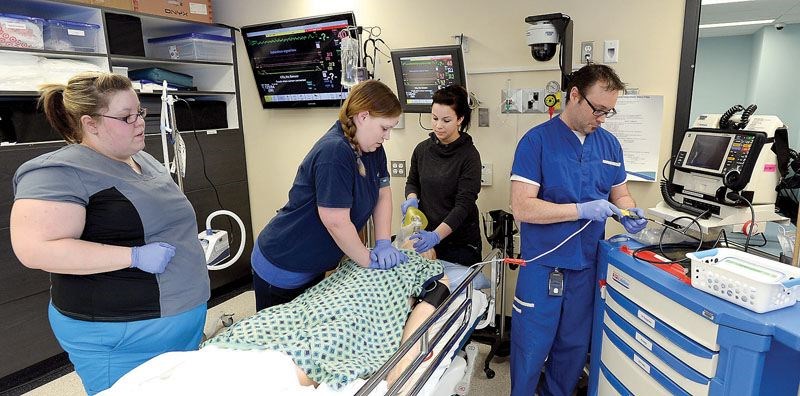The University Hospital of Northern B.C. is home to a patient who seems to suffer a new catastrophic medical condition every single day.
From heart attacks to gun shot wounds to brain injuries, this particular patient has gone through it all, often many times over. Despite their best efforts to ensure he recovers from each malady, Northern Health is happy SimMan 3G never gets better.
The high-tech, high-fidelity training tool has been used for the past two years to give medical professionals hands on practice in a team setting.
"It's a controlled, safe environment where the students and healthcare workers can practice and hone their skills," Northern Clinic Simulation Centres coordinator Michael Lundin said.
SimMan 3G can mimic almost anything an actual patient can do. He can cry, bleed, urinate and even foam at the mouth. His chest goes up and down to allow people to monitor breathing and he has a pulse that can be checked as the scenarios play out.
"It's really good practice, you really have to get in there," clinical nurse educator Kathy Innis said. "You're not sitting behind a PowerPoint, no one gets to sit back and be a wallflower."
Instructors leave the room during the simulation to observe the medical teams, but they can hear and see everything that's going on and speak as SimMan to interact with the practitioners.
"There's a great amount of detail that goes into the session planning, both for the patient responses as well as the room supply and the equipment itself," Lundin said.
Nurse Amanda Conroy said SimMan 3G has been a useful training aid during her career.
"I've found that it's really helpful when we're doing the code management because it's hands-on, you can see it as its happening rather than trying to picture something in your head," she said.
In addition to getting sick a lot, SimMan 3G gets treated by a wide variety of people. Nurses, physicians and other Northern Health medical staff use him to keep their training current. He's also used by students in UNBC's nursing program and the Northern Medical Program.
"It's a really good tool for yearly competencies and ongoing competencies," Innis said. "Or just basic stuff you don't see every day."
In fact, it was a decision by Northern Health, UNBC and the NMP to pool their training funds that allowed the simulation program to get off the ground.
SimMan 3G's home is the Northern Clinic Simulation Lab on the third floor at UHNBC, but he also travels around to different wards for monthly hospital training exercises. In the past six months he's also been on the road to Vanderhoof to give medical staff there a chance to engage in the interactive training.
In addition to Prince George, Northern Health also has simulation centres in Quesnel, Terrace and Fort St. John.
SimMan 3G isn't the only simulator in the program. The health authority and its educational partners also have infant and child simulators for pediatric training and a pregnant simulator which gives birth to a sim baby to give medical teams a chance to practice different labour and delivery scenarios.
If funding is secured, program could also include an operating room simulation which would allow medical professionals to practice even more specialized scenarios in a realistic setting.
The use of the Northern Clinic Simulation Lab increased by 10 per cent from 2012 to 2013 and is often fully booked. The lab won the technology award at last year's A Healthier You gala.
The simulators are expected to last for five years, but Lundin said with proper maintenance they're hoping to keep Prince George's SimMan 3G in service for at least seven years. High fidelity simulators range in cost from $30,000 to $80,000 a piece, with SimMan 3G on the upper end of that scale.
Next year SimMan 3G and his related equipment will move into the new $10 million Learning and Development Centre which is currently under construction next to UHNBC. The new building will have enough space to provide the full range of simulator training on site, which is not currently the case.
"We're going to have separate control rooms and actual added space where we can have everything stored," Lundin said. "One of the huge advantages of the new space is having large lecture and presentation rooms adjacent to the simulation rooms."
Diagnosing and treating SimMan 3Gs problems are just the start of the training exercise. Medical professionals and students also learn from the debriefing after the event, which includes watching videos of happened so they can learn from what worked and what didn't.
Lundin said students are never graded on their work on the simulator, instead it's strictly a learning tool.
"We use an advocacy-inquiry method where instructors make observations as to what's happening and then inquire as to what frame the student is at or the healthcare worker is at," he said. "They really get to see how they're reacting in the room, how the communications is happening and focus on people and process and not on errors."

.png;w=120;h=80;mode=crop)

